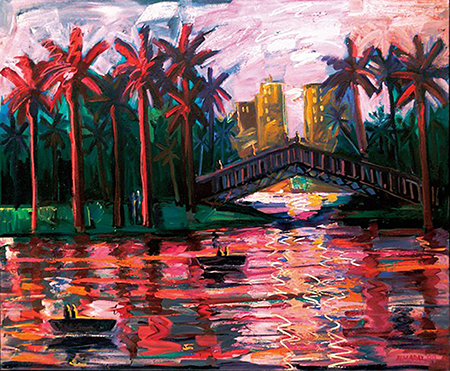
Continuing through December 3, 2017
An influential member of the Chicano Art Movement and a founder of the art collective Los Four, Carlos Almaraz is perhaps less known than some of his contemporaries because of his premature death at 48. In this first major retrospective of his work, "Playing with Fire: Paintings by Carlos Almaraz," his vibrant paintings and pastels from the 1970s and 80s, watershed decades in LA’s cultural history, reflect his exhilaration in being part of the life of this city. The exhibition boasts more than 60 large oil paintings, pastels and drawings, and also includes a room of ephemera and notebooks from the late 1960s through 1989, when he died.
Born in Mexico City, Almaraz and his family immigrated to the U.S. when he was an infant. They eventually settled in California when he was 10. In the early days of his career, he saw art in connection to political activism. It was the era of the California farm worker’s movement led by Cesar Chavez and Dolores Huerta, and he made political banners, theater backdrops and murals. Later, wanting to be taken more seriously as an artist, he moved towards more personal and dreamlike imagery, and this is where the exhibition concentrates.
The high-keyed colors and energetic slashes of paint strike one upon entry into the show. The first two rooms show a poetic, romanticized view of life in Los Angeles and Hawaii, where he and his wife often visited. There are lush tropical scenes of people lolling under palm trees, cars driving along a lakeside road. Here, the four-part, tour de force painting “Echo Park Lake” (1982) occupies an entire wall. It’s a magical panorama of the lake at dusk, with small rowboats drifting on a sea of shimmering flecks of light. On the facing shore is a stand of palms, tall trunks topped with tousled palm fronds, and a wedding couple, looking across the water at us. They’re executed with a few adept strokes, the bride a cascade of white, the groom in a dark suit. People stroll along the lake, and behind them, in the far distance, are the peaked roof lines of houses and industrial buildings behind that. One can get lost staring at this painting, focusing on different details, and feeling drawn into this world.
The middle and largest gallery is filled with several series. One of his most recognizable is of cars crashing and/or burning on the freeway, a sight anyone who's lived in LA long enough will see. Especially iconic is “Crash in Phthalo Green” (1984), a personal favorite of museum director Michael Govan, who selected it to hang in his office. In this painting two cars have burst into angry orange and red flames on an elevated freeway, with black smoke trailing behind, while a sky of yellow, pink and mauve swirls overhead. Almaraz, playing with the paint here, conveys a terrible beauty in the destruction, rather than reaching for precise depiction. On the lower register of the painting are two intact sedans, moving along in a peaceful progression which contrasts with what is happening above.
Throughout the show we see how Almaraz was inspired by Mesoamerican culture, as well as European art. In several works there is the figure of the jaguar man — in Meso American lore the jaguar was seen as strong and agile, having the ability to move between worlds. One suspects that Almaraz saw himself, as an artist, in this role of transformation, he also identified with the figure of the magician, which he depicted often. Elsewhere we can see echoes of Monet in what look like lily pads in Echo Park Lake, or of Picasso in his various drawings and paintings of couples leisurely reclining. As noted in the quite beautifully written chapter in the catalog by his widow, Elsa Flores Almaraz, says, the artist was fortunate enough to find his own idiom and expression before he died.
